Windshield TOYOTA SEQUOIA 2008 2.G Owners Manual
[x] Cancel search | Manufacturer: TOYOTA, Model Year: 2008, Model line: SEQUOIA, Model: TOYOTA SEQUOIA 2008 2.GPages: 596, PDF Size: 12.93 MB
Page 3 of 596
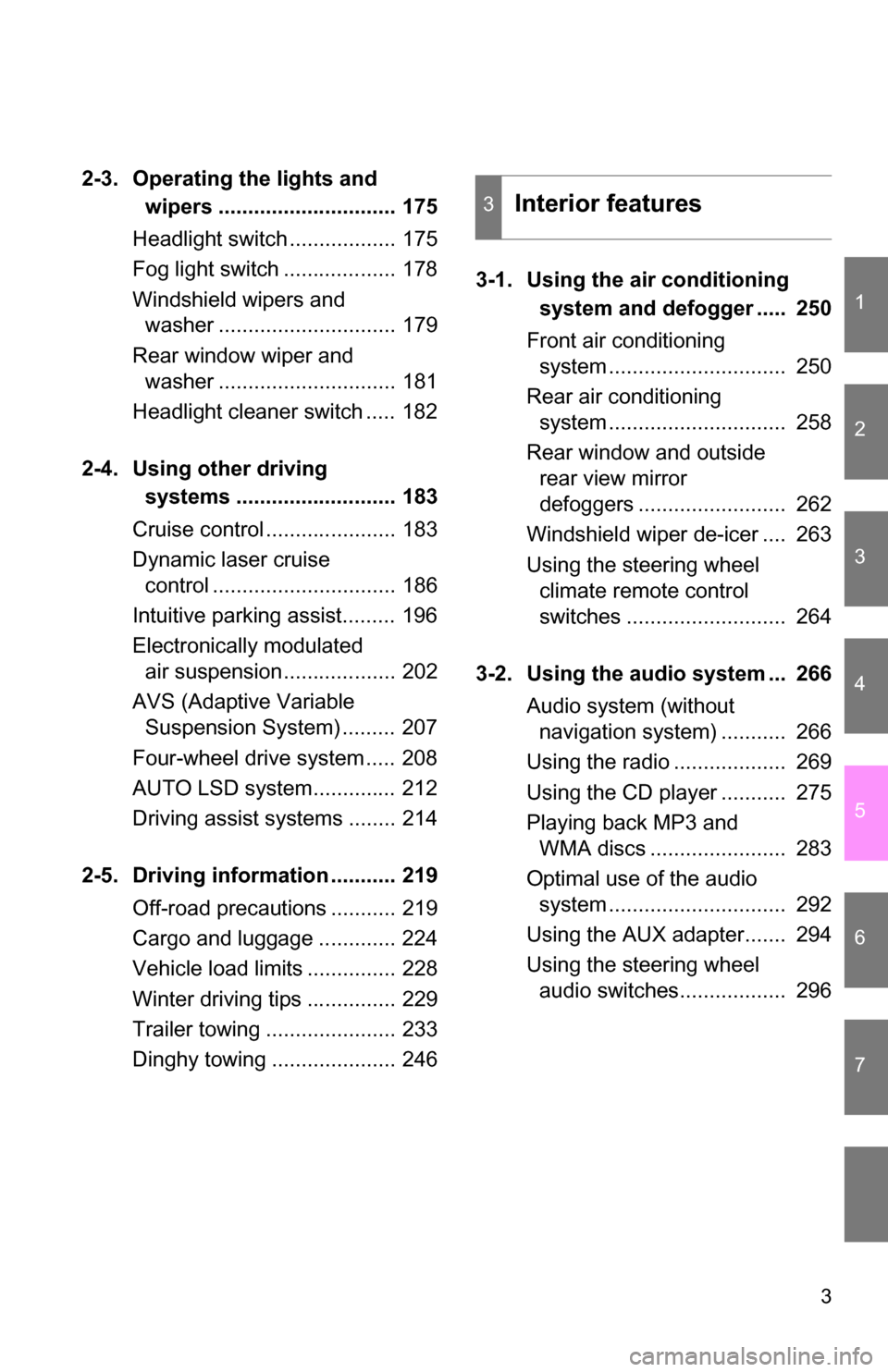
1
2
3
4
5
6
7
3
2-3. Operating the lights and wipers .............................. 175
Headlight switch .................. 175
Fog light switch ................... 178
Windshield wipers and washer .............................. 179
Rear window wiper and washer .............................. 181
Headlight cleaner switch ..... 182
2-4. Using other driving systems ........................... 183
Cruise control ...................... 183
Dynamic laser cruise control ............................... 186
Intuitive parking assist......... 196
Electronically modulated air suspension................... 202
AVS (Adaptive Variable Suspension System) ......... 207
Four-wheel drive system ..... 208
AUTO LSD system.............. 212
Driving assist systems ........ 214
2-5. Driving information ........... 219 Off-road precautions ........... 219
Cargo and luggage ............. 224
Vehicle load limits ............... 228
Winter driving tips ............... 229
Trailer towing ...................... 233
Dinghy towing ..................... 246 3-1. Using the air conditioning
system and defogger ..... 250
Front air conditioning system .............................. 250
Rear air conditioning system .............................. 258
Rear window and outside rear view mirror
defoggers ......................... 262
Windshield wiper de-icer .... 263
Using the steering wheel climate remote control
switches ........................... 264
3-2. Using the audio system ... 266 Audio system (without navigation system) ........... 266
Using the radio ................... 269
Using the CD player ........... 275
Playing back MP3 and WMA discs ....................... 283
Optimal use of the audio system .............................. 292
Using the AUX adapter....... 294
Using the steering wheel audio switches.................. 296
3Interior features
Page 8 of 596

8
Headlights (high beam) P. 175
Pictorial indexExterior
Hood
P. 437
Windshield wipers
P. 179
Outside rear view
mirrors
P. 79
Front turn signal/parking
lights
P. 155, 175
Moon roof P. 89
Fog lights P. 178
Headlights (low beam) P. 175
Front side marker lights
P. 175
Page 18 of 596
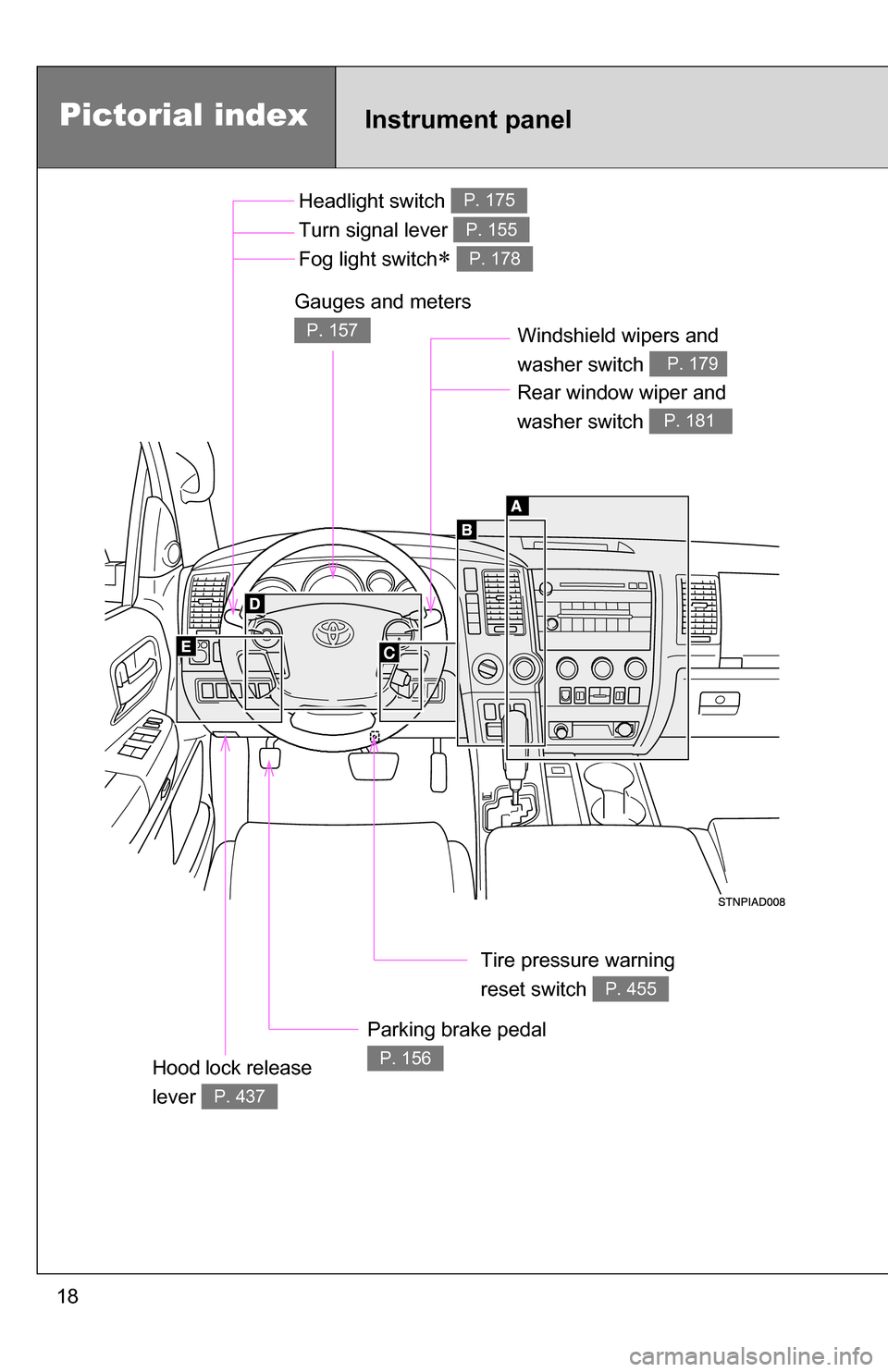
18
Pictorial indexInstrument panel
Headlight switch
Turn signal lever
Fog light switch
P. 175
P. 155
P. 178
Windshield wipers and
washer switch
P. 179
Parking brake pedal
P. 156
Gauges and meters
P. 157
Hood lock release
lever
P. 437
Tire pressure warning
reset switch
P. 455
Rear window wiper and
washer switch
P. 181
Page 19 of 596
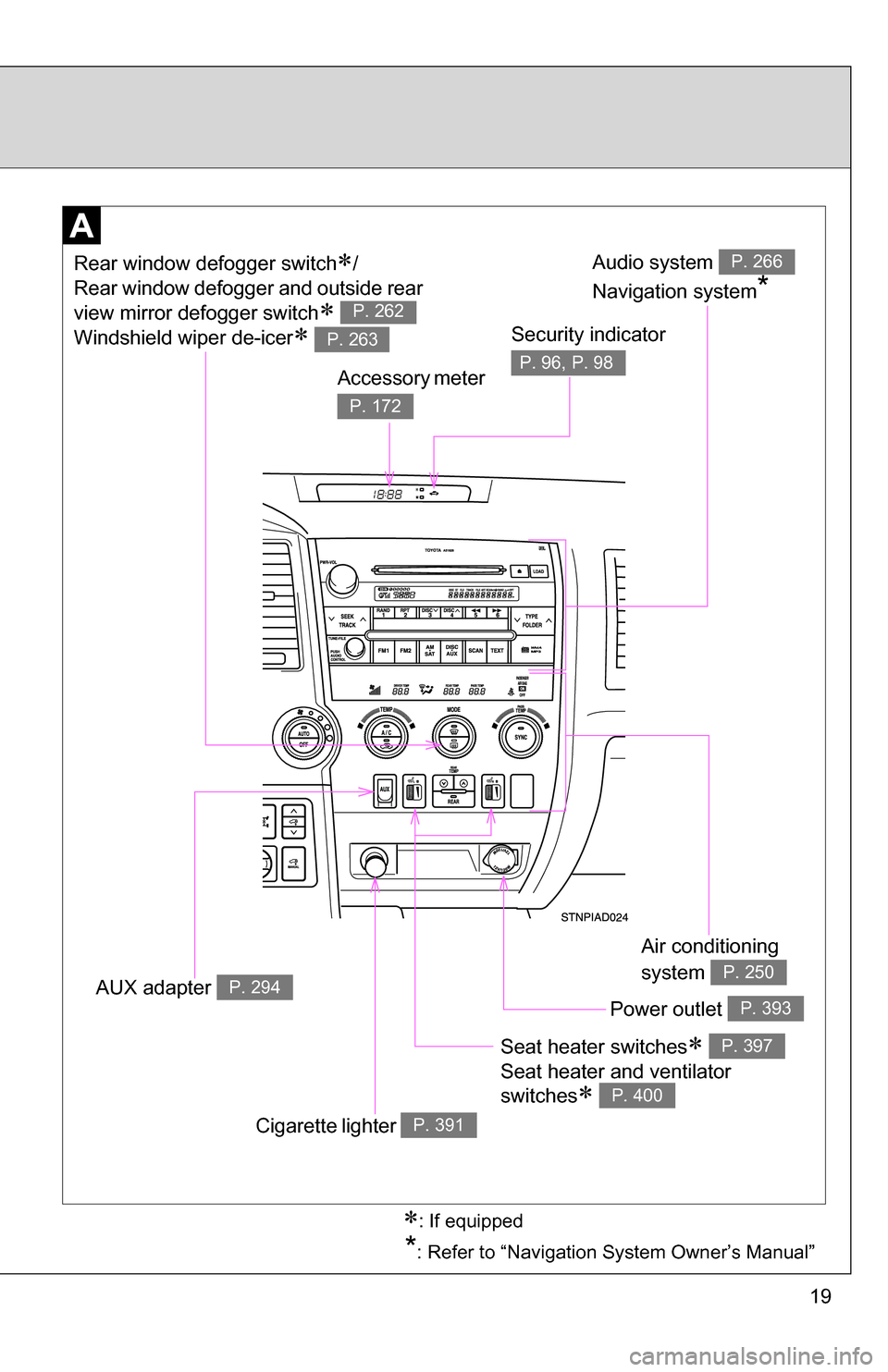
19
*: Refer to “Navigation System Owner’s Manual”
Seat heater switches
Seat heater and ventilator
switches
P. 397
P. 400
Air conditioning
system
P. 250
Power outlet P. 393
Audio system
Navigation system
*
P. 266Rear window defogger switch/
Rear window defogger and outside rear
view mirror defogger switch
Windshield wiper de-icer
P. 262
P. 263Security indicator
P. 96, P. 98Accessory meter
P. 172
Cigarette lighter P. 391
AUX adapter P. 294
: If equipped
Page 105 of 596
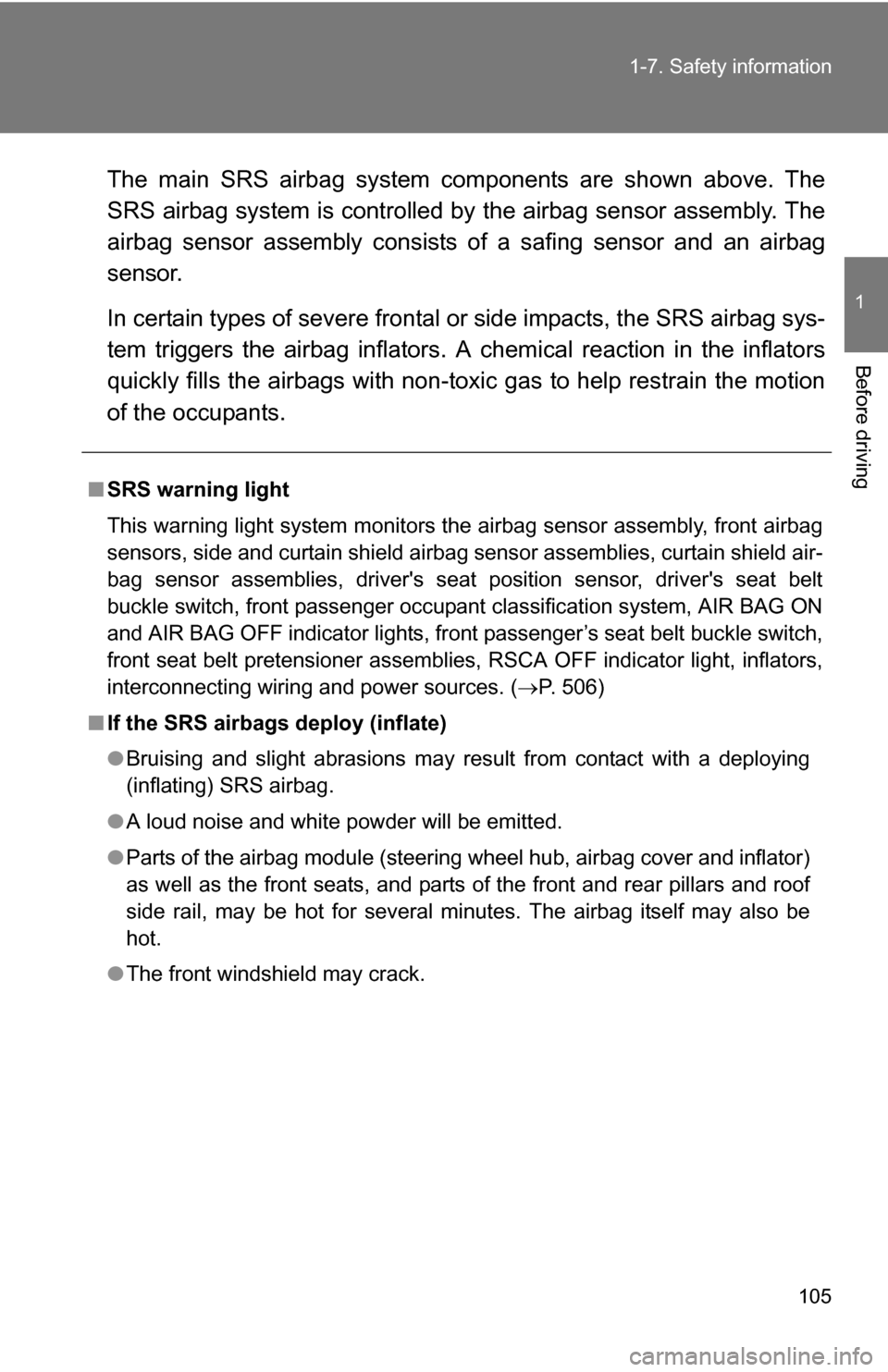
105
1-7. Safety information
1
Before driving
The main SRS airbag system components are shown above. The
SRS airbag system is controlled by
the airbag sensor assembly. The
airbag sensor assembly consists of a safing sensor and an airbag
sensor.
In certain types of severe frontal or side impacts, the SRS airbag sys-
tem triggers the airbag inflators. A chemical reaction in the inflators
quickly fills the airbags with non-toxic gas to help rest rain the motion
of the occupants.
■ SRS warning light
This warning light system monitors the airbag sensor assembly, front airbag
sensors, side and curtain shield airbag sensor assemblies, curtain shield air-
bag sensor assemblies, driver's seat position sensor, driver's seat belt
buckle switch, front passenger occupant classification system, AIR BAG ON
and AIR BAG OFF indicator lights, front passenger’s seat belt buckle switch,
front seat belt pretensioner assemblies , RSCA OFF indicator light, inflators,
interconnecting wiring and power sources. ( P. 506)
■ If the SRS airbags deploy (inflate)
●Bruising and slight abrasions may result from contact with a deploying
(inflating) SRS airbag.
● A loud noise and white powder will be emitted.
● Parts of the airbag module (steering wheel hub, airbag cover and inflator)
as well as the front seats, and parts of the front and rear pillars and roof
side rail, may be hot for several minutes. The airbag itself may also be
hot.
● The front windshield may crack.
Page 113 of 596
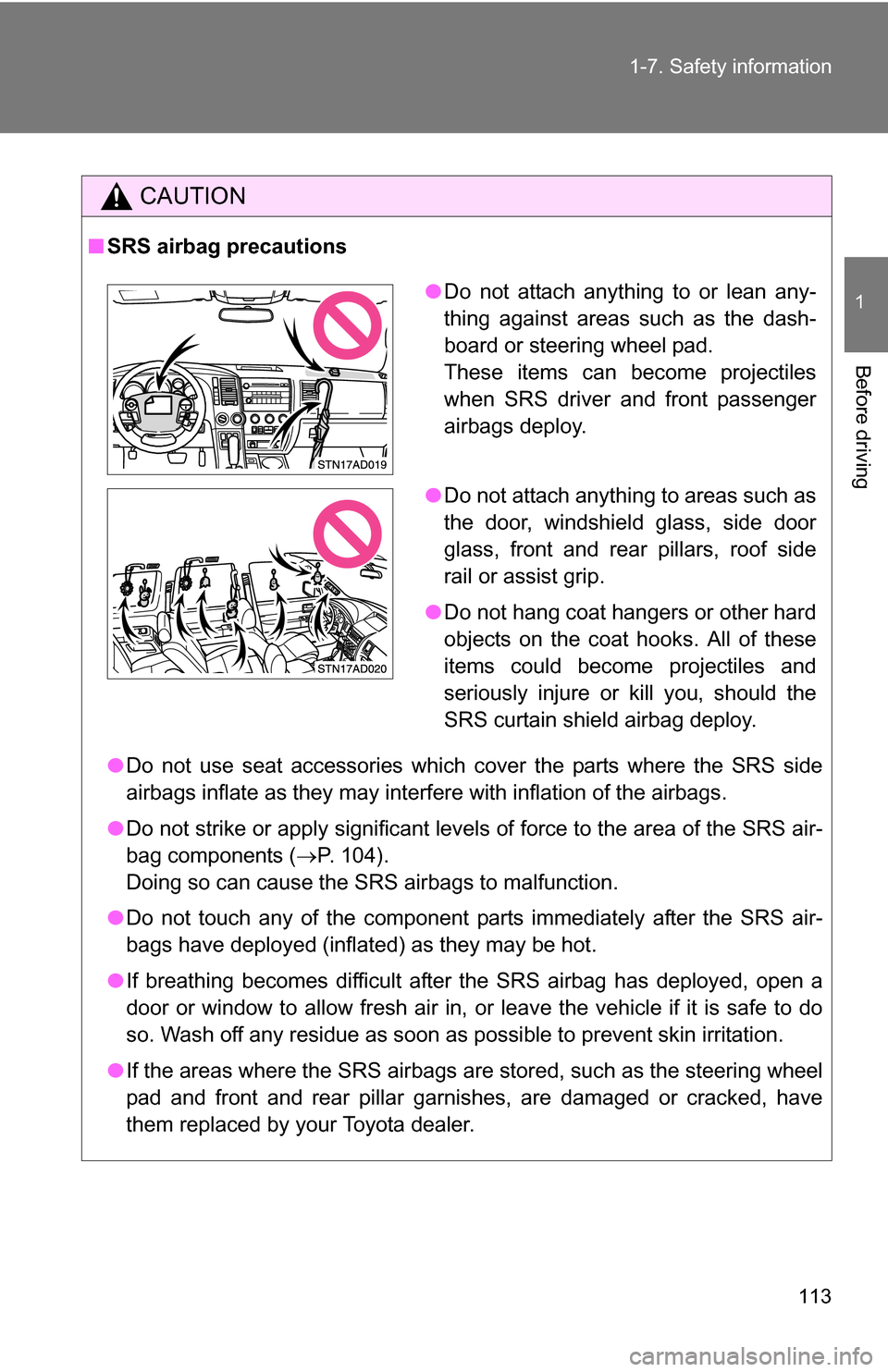
113
1-7. Safety information
1
Before driving
CAUTION
■
SRS airbag precautions
●Do not use seat accessories which cover the parts where the SRS side
airbags inflate as they may interf ere with inflation of the airbags.
● Do not strike or apply significant levels of force to the area of the SRS air-
bag components ( P. 104).
Doing so can cause the SRS airbags to malfunction.
● Do not touch any of the component parts immediately after the SRS air-
bags have deployed (inflated) as they may be hot.
● If breathing becomes difficult after the SRS airbag has deployed, open a
door or window to allow fresh air in, or leave the vehicle if it is safe to do
so. Wash off any residue as soon as possible to prevent skin irritation.
● If the areas where the SRS airbags are stored, such as the steering wheel
pad and front and rear pillar garnishes, are damaged or cracked, have
them replaced by your Toyota dealer.
●Do not attach anything to or lean any-
thing against areas such as the dash-
board or steering wheel pad.
These items can become projectiles
when SRS driver and front passenger
airbags deploy.
● Do not attach anything to areas such as
the door, windshield glass, side door
glass, front and rear pillars, roof side
rail or assist grip.
● Do not hang coat hangers or other hard
objects on the coat hooks. All of these
items could become projectiles and
seriously injure or kill you, should the
SRS curtain shield airbag deploy.
Page 123 of 596
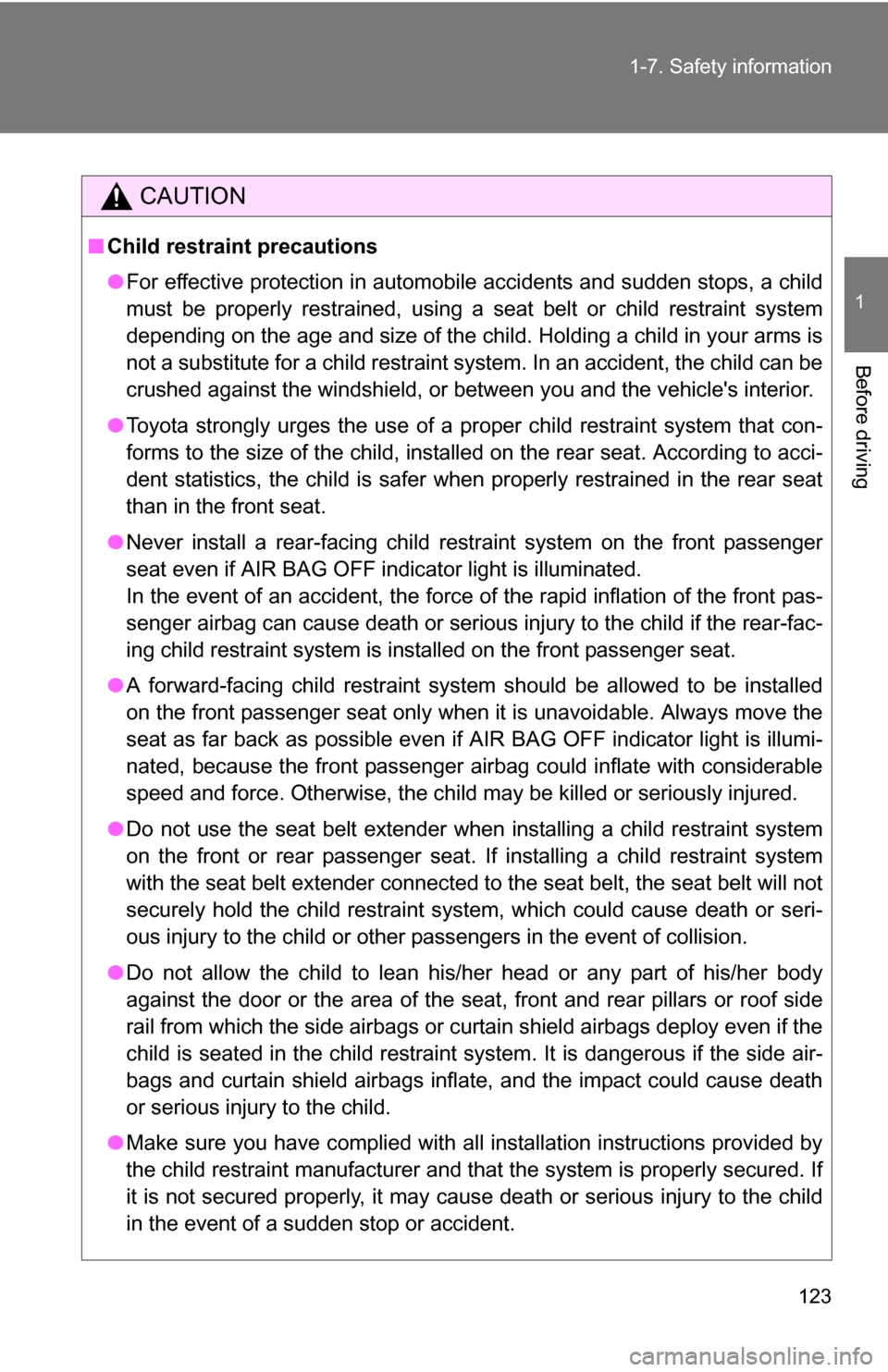
123
1-7. Safety information
1
Before driving
CAUTION
■
Child restraint precautions
●For effective protection in automobile accidents and sudden stops, a child
must be properly restrained, using a seat belt or child restraint system
depending on the age and size of the child. Holding a child in your arms is
not a substitute for a child restraint system. In an accident, the child can be
crushed against the windshield, or between you and the vehicle's interior.
● Toyota strongly urges the use of a proper child restraint system that con-
forms to the size of the child, installed on the rear seat. According to acci-
dent statistics, the child is safer when properly restrained in the rear seat
than in the front seat.
● Never install a rear-facing child restraint system on the front passenger
seat even if AIR BAG OFF indicator light is illuminated.
In the event of an accident, the force of the rapid inflation of the front pas-
senger airbag can cause death or serious injury to the child if the rear-fac-
ing child restraint system is installed on the front passenger seat.
● A forward-facing child restraint system should be allowed to be installed
on the front passenger seat only when it is unavoidable. Always move the
seat as far back as possible even if AIR BAG OFF indicator light is illumi-
nated, because the front passenger airbag could inflate with considerable
speed and force. Otherwise, the child may be killed or seriously injured.
● Do not use the seat belt extender when installing a child restraint system
on the front or rear passenger seat. If installing a child restraint system
with the seat belt extender connected to the seat belt, the seat belt will not
securely hold the child restraint system, which could cause death or seri-
ous injury to the child or other passengers in the event of collision.
● Do not allow the child to lean his/her head or any part of his/her body
against the door or the area of the seat , front and rear pillars or roof side
rail from which the side airbags or curtain shield airbags deploy even if the
child is seated in the child restraint system. It is dangerous if the side air-
bags and curtain shield airbags inflate, and the impact could cause death
or serious injury to the child.
● Make sure you have complied with all installation instructions provided by
the child restraint manufacturer and that the system is properly secured. If
it is not secured properly, it may cause death or serious injury to the child
in the event of a sudden stop or accident.
Page 135 of 596
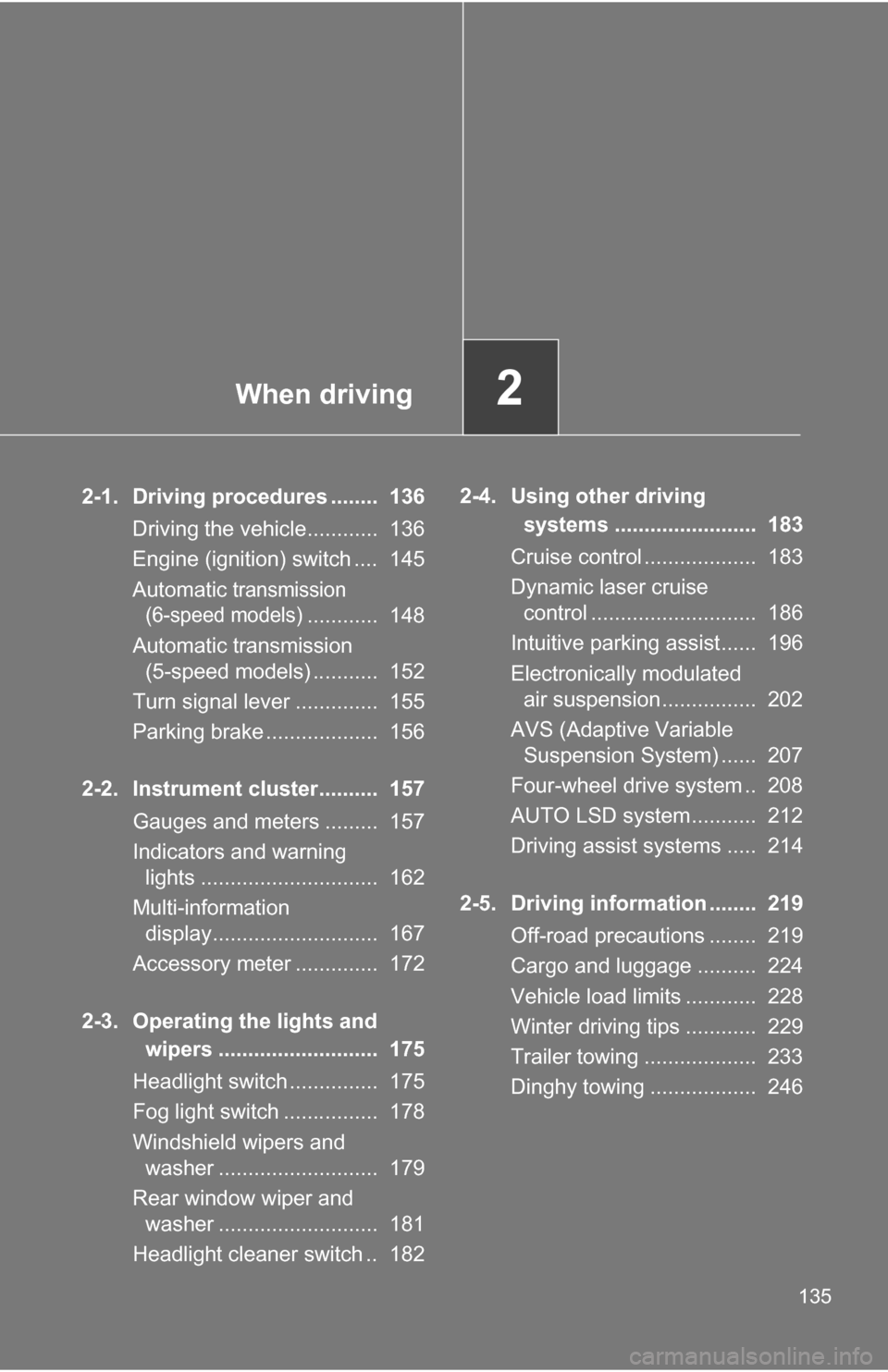
When driving2
135
2-1. Driving procedures ........ 136Driving the vehicle............ 136
Engine (ignition) switch .... 145
Automatic
transmission
(6-speed models)
............ 148
Automatic transmission (5-speed models) ........... 152
Turn signal lever .............. 155
Parking brake ................... 156
2-2. Instrument cluster.......... 157 Gauges and meters ......... 157
Indicators and warning lights .............................. 162
Multi-information display............................ 167
Accessory meter .............. 172
2-3. Operating the lights and wipers ........................... 175
Headlight switch ............... 175
Fog light switch ................ 178
Windshield wipers and washer ........................... 179
Rear window wiper and washer ........................... 181
Headlight cleaner switch .. 182 2-4. Using other driving
systems ........................ 183
Cruise control ................... 183
Dynamic laser cruise control ............................ 186
Intuitive parking assist...... 196
Electronically modulated air suspension ................ 202
AVS (Adaptive Variable Suspension System) ...... 207
Four-wheel drive system .. 208
AUTO LSD system........... 212
Driving assist systems ..... 214
2-5. Driving information ........ 219 Off-road precautions ........ 219
Cargo and luggage .......... 224
Vehicle load limits ............ 228
Winter driving tips ............ 229
Trailer towing ................... 233
Dinghy towing .................. 246
Page 176 of 596

176 2-3. Operating the lights and wipers
■Daytime running light system (if equipped)
To make your vehicle more visible to other drivers, the front turn signal lights
turn on automatically whenever the engine is started and the parking brake
is released. Daytime running lights are not designed for use at night.
■ Headlight control sensor
■ Automatic light off system
●When the headlights come on: The headlights and tail lights automati-
cally turn off after 30 seconds when all doors are closed with the engine
switch turned to the ACC or LOCK position. (The lights turn off immedi-
ately if the button on the wireless remote control is pressed after all
doors are locked.)
● When only the tail lights come on: The tail lights turn off automatically
with the engine switch turned to the ACC or LOCK position and the
driver’s door is opened.
To turn the lights on again, turn the engine switch to the ON position, or turn
the headlight switch off once and then back to the or position.
■ Customization
●That can be configured at Toyota dealer (vehicles without multi-informa-
tion display)
Settings (automatic light off system) can be changed. (Customizable
features P. 569)
● It is possible to change the settings (vehicles with multi-information dis-
play) (Feature customization P. 169)
The sensor may not function properly if
an object is placed on the sensor, or any-
thing that blocks the sensor is affixed to
the windshield.
Doing so interferes with the sensor
detecting the level of ambient light and
may cause the automatic headlight sys-
tem to malfunction.
Page 179 of 596
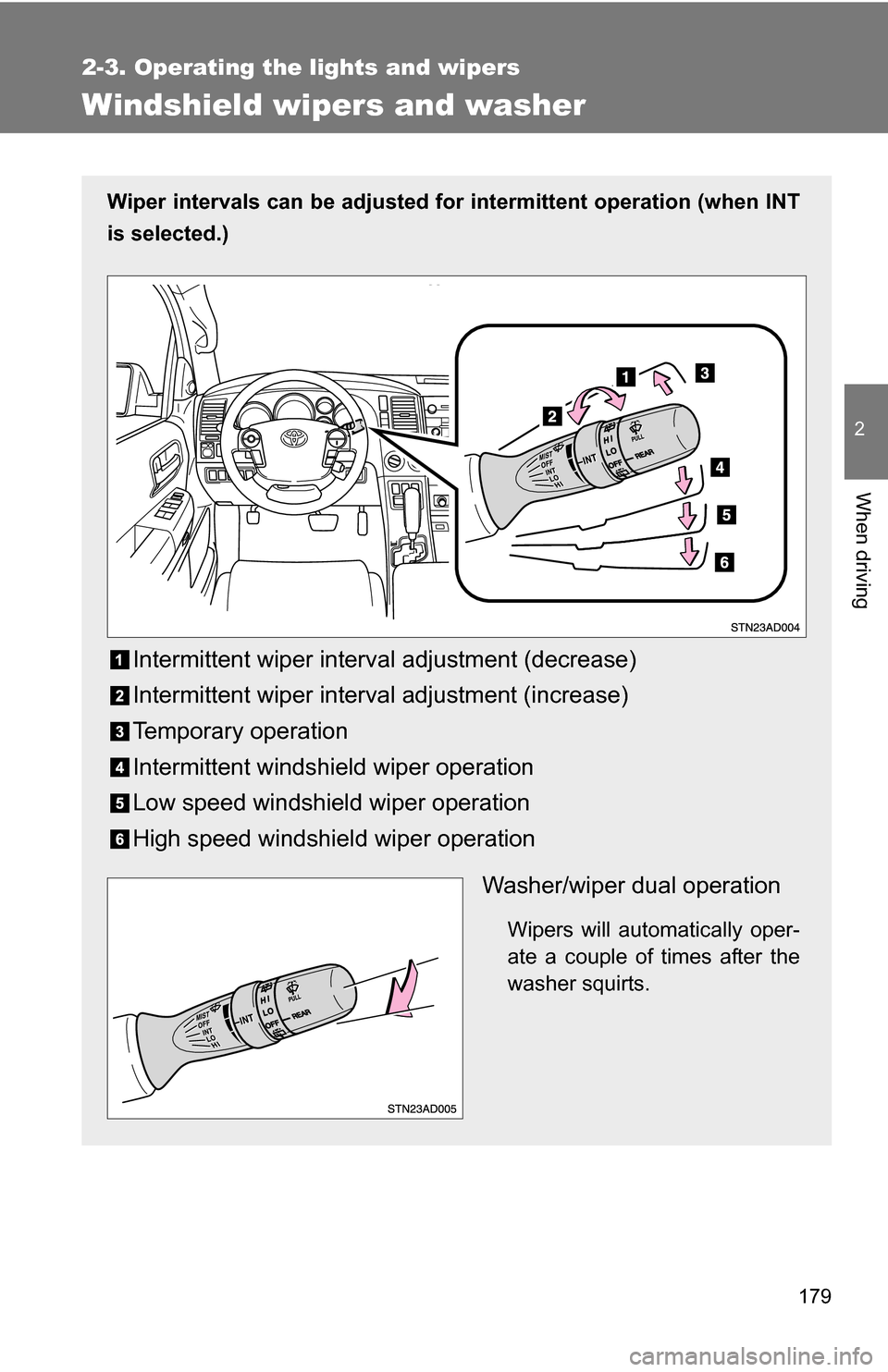
179
2-3. Operating the lights and wipers
2
When driving
Windshield wipers and washer
Wiper intervals can be adjusted for intermittent operation (when INT
is selected.)
Intermittent wiper interval adjustment (decrease)
Intermittent wiper interval adjustment (increase)
Temporary operation
Intermittent windshi eld wiper operation
Low speed windshield wiper operation
High speed windshiel d wiper operation
Washer/wiper dual operation
Wipers will automatically oper-
ate a couple of times after the
washer squirts.